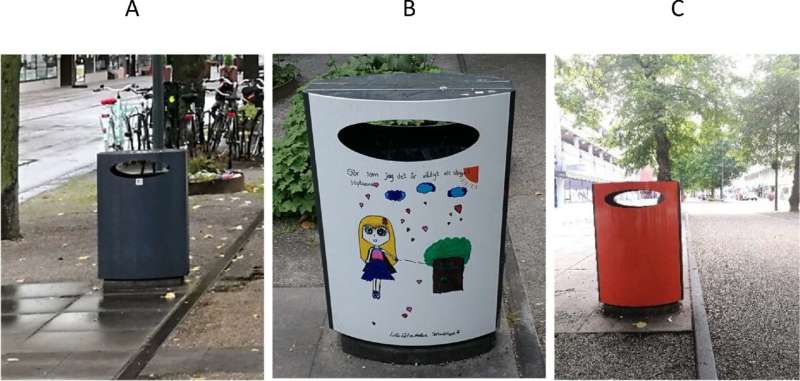This article has been reviewed according to Science X's editorial process and policies. Editors have highlighted the following attributes while ensuring the content's credibility:
fact-checked
proofread
Rubbish bins designed with children's drawings rejected by residents

Does the design of a rubbish bin affect the amount of litter thrown into it? A new study published in Resources, Conservation & Recycling Advances has compared the amount of litter put in outdoor rubbish bins with different designs.
In the past, rubbish trash bins in Swedish cities were green, but in recent years, they are more commonly gray or black. But are their design significant for how much litter people put in them? Researchers at University of Gävle investigated the effect of the design by comparing three different types of rubbish bins in Gävle over a month.
The rubbish bins had three different designs: one type was gray, resembling those already in use in Gävle. Another type had a distinct orange color, while one type was covered with children's drawings and messages emphasizing the importance of protecting the environment. A total of nine bins, three of each type, were placed in Gävle over four weeks. Their positions were rotated during this period, ensuring that all types of bins received identical exposure throughout the experiment. The content of each bin was continuously weighed to measure the amount of collected litter.
"We didn't have a clear idea of which bin that would perform the best, but we assumed that both the orange one and the one with children's drawings would work better and collect more litter than the gray one," says Patrik Sörqvist, a professor of psychology and one of the researchers behind the study.
The orange rubbish bin proved to be the most effective followed by the gray one. Surprisingly, the bin with children's drawings came in last. The orange bin collected more than 2 kilograms of litter on average, while the gray one collected 1.5 kilograms, but the one with children's drawings only collected 0.5 kilograms. Therefore, the orange bin was four times more effective than the one with children's drawings.
"Even though we had high expectations for the orange one, the result for the type with children's drawings was surprisingly weak. The reason why is probably because people tend to rebel against normative messages. If a sign provides moral guidance and tell people what to do, many people become irritated and do the opposite instead. So, using normative messages is not necessarily an effective method if you strive to influence people's behavior. The results of the study highlight the importance of evaluating the effectiveness of different solutions before implementing them on a large scale," says Patrik Sörqvist.
Did people fail to understand that the type decorated with children's drawings was a rubbish bin?
"To ensure that people understood that this type was a rubbish bin, we conducted an additional study where we showed photographs of the rubbish bins to several participants. In this way, we could determine that people didn't find it difficult to identify the type with children's drawings as a rubbish bin."
The reason why the orange bin contained more litter was probably because it simply stood out more and captured people's attention, according to the researchers.
"The problem is that the orange one doesn't blend in as well with the urban environment as the gray one. When planning to replace rubbish bins, you should take such considerations into account. We need stylish solutions that also maximize utility," Patrik Sörqvist says.
By far, the most litter was thrown on weekends; the researchers assume that this is so because more people spend time outdoors and have a different consumption pattern compared to the weekdays.
More information: Noah Linder et al, Managing waste behavior by manipulating the normative appeal of trash bins: Lessons from an urban field experiment, Resources, Conservation & Recycling Advances (2023). DOI: 10.1016/j.rcradv.2023.200186
Provided by University of Gävle




















